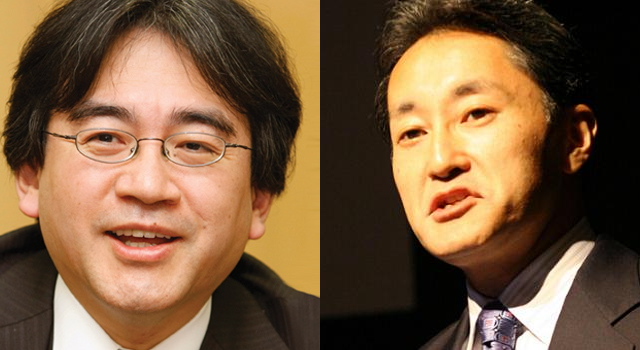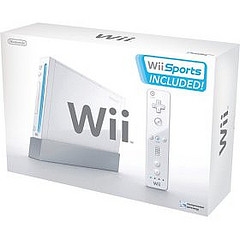 Not content with two former coworkers screaming until they were blue in the face, I dredged Ryan Green, TotalPlayStation’s managing editor (and Sam Bishop’s cabin boy – take from that what you will), out to help form a Holy Trinity of Sony fanboyism. Call it a Triforce, if you will, invoked to tackle the thorny issues of the PlayStation Vita’s impending – and impending and impending – launch and the ultimate future of both companies, handheld and console.
Not content with two former coworkers screaming until they were blue in the face, I dredged Ryan Green, TotalPlayStation’s managing editor (and Sam Bishop’s cabin boy – take from that what you will), out to help form a Holy Trinity of Sony fanboyism. Call it a Triforce, if you will, invoked to tackle the thorny issues of the PlayStation Vita’s impending – and impending and impending – launch and the ultimate future of both companies, handheld and console.
What I find absolutely enthralling about Sony and Nintendo is that they both make hugely asinine mistakes (as well as great games, of course) borne from the very same mentality. Sony is also a hugely stubborn company, so much so that it really does believe, for instance, that it can release $600 consoles without experiencing even a hitch in its install base. The company seems to be learning its lesson with the Vita, but are you guys even a little worried that the launch will go over like the PS3’s or the PSP’s?
Parjanya Holtz, senior editor:
Market and consumer reaction is always difficult to predict. Few people foresaw the Wii selling the way it did, and the Vita being a handheld makes things even more complicated. Also, keep in mind that solely relying on hardware sales may not be such a reliable indicator of a console’s success. The PSP sold a ton of units internationally, only to die a slow, painful death in terms of software sales. Piracy, of course, played a huge role here, but there are other aspects as well, such as consumers jumping in on the hype of a shiny new product they don’t really need. Again, that’s very much what the Wii went through, and it’s really difficult to say if it’ll be any different with the Vita.
Perhaps software needs to be less expensive. Have all Vita games be $20 or less, and I can see myself buying those kind of games more regularly. Anything above that is a serious commitment few people are willing to invest into when you have all these fantastic console games waiting to be played back home. But this may exactly be where the Vita’s PS3 connectivity could revolutionize the way we regard portable gaming – buy a game on the PS3 and transfer it to your Vita for either free or a small fee to play on the bus or the plane… imagine how compelling that would be!
Do I really still play games when I’m not at home? Very rarely, if ever. Do I want a Vita because it’s shiny, sexy, and it’ll have Uncharted? Fuck yeah. In that regard, the Vita is as attractive as the PSP was back in the day. Let’s hope it has more to offer in the long run.
However, that’s an issue I have with the DS and 3DS as well. I’m just not part of the target audience anymore; that passed seven to eight years ago. But, ultimately, with the current price and all the fancy touch-screen, motion-sensor tech the system has to offer, really the worst that could happen, I think, is killer launch(?) titles such as the aforementioned Uncharted being pushed back into late next year and the lineup looking just as week as Nintendo’s with the 3DS. And, of course, software needs to keep coming in the months following the release to keep that momentum up. In fact, I believe that’s even more important than what games will be available on day one.

Cooking Mama is just not Parjanya’s cup of tea anymore.
Aram Lecis, (more) senior editor:
At this point, I’m more worried that the launch will be like the 3DS, unfortunately. I think this is a very difficult time to be launching a handheld system, and the lukewarm reception Nintendo has gotten after the initial early adopter phase ended is quite troubling. A bad economy, the rise of smartphones, and a bit of gaming fatigue have all combined to make a handheld gaming system a somewhat redundant luxury.
On the other hand, Nintendo has run into a software issue and isn’t keeping up on either retail or downloadable releases, and that is definitely a part of the problem they are seeing. As Paji said, Sony, if the claims are to be believed, is going to have a pretty impressive lineup of game at or near launch. Very importantly, they are porting a ton of PSN content to the Vita, and that gives them a ready-made pool of good, affordable software. That might be good enough to move some units.
I also agree with Paji that part of the issue that will be facing the Vita is that I just don’t have much need to game outside my home, and at home, I want to game on my TV. I don’t live in a place with mass transit, and I’m generally expected to engage with other humans when I leave home, anyway. Truth be told, my PSP gets the most use at bedtime, when it occasionally replaces a book as the distraction that gets me over the hump to fall asleep (otherwise, my mind is racing replaying every conversation I had that day in my head). That, and airplane rides are my only serious portable gaming time, and more often than not these days, I’m using my iPhone in that situation.
In summary… I have a great deal of worry that Sony can do everything right with this launch (and seemingly they are, with a feature-packed device at a reasonable price and good software support out of the gate) yet still struggle to find success in a market that is shifting away from what they are offering.
Ryan Green, managing editor:
Having a low price point is always ideal, but you have to imagine that larger studios that pump a lot of resources into a mobile platform are going to want a pretty big return on their investment per unit sold. For a smaller studio, that really isn’t a risk, which is why we have platforms like PlayStation Minis and various phone App Stores that have generally low barriers of entry. That’s great if you love games like Angry Birds (which I loathe), but a several-hundred hour RPG that needs to be translated and essentially re-written (like many games from Nippon Ichi Software) is an incredibly niche market. If you start to standardize games being a certain price point and it is too low for some titles, you are going to see a lot of studios and publishers either abandon the platform or be forced to close down.
None of these price points are out of stubbornness. The PS3 launching at the price it did was to remain economically viable for the company. Turns out that idea wasn’t so hot when you’re late to the party and have comparable hardware loadouts. The same goes for a studio making a game and selling it for a given price. Unless you are a power-hungry board member, you want to have that low price barrier so you can get your game into as many hands as possible. But in both cases, it just isn’t something they can financially support. Meanwhile, Nintendo was making record profits following the Wii’s launch, and some of those overall numbers came from DS sales. They were able to do that with a product that hit its target demographics perfectly (predating much of the now-commonplace cell phone gaming market) while maintaining a lower production cost. DS hardware didn’t exactly reinvent the wheel, unless we compare it solely with how Game Boy Advance games looked.

Satoru Iwata’s NCL and Kaz Hirai’s SCEI – two sides of the same coin?
Considering how “Japanese” these Japanese-based companies are, it is no wonder they are being so stubborn when it comes to change. The global market is vastly different than it was in 2004, when the DS launched, yet Nintendo is treating everyone like the past seven years didn’t happen at all. Even the 3D “revolution” didn’t pan out at all, but they still wanted to produce a cheap and ultimately under-powered handheld to a jaded consumer base. There will always be gamers that will buy your products, and while I do proudly own a Virtual Boy, I doubt I helped their sales in that case. Sony is a company known for higher-end-yet-obtainable consumer electronics (or, at least, when it comes to computers and TVs, they are), but they get the picture over at SCEI that they need to make their systems at a competitive price while having attractive hardware specs. If that means taking a loss on hardware sales (which is the last thing a hardware company wants to do), they seem willing to do it. Now, that is.
So, am I worried that these launches will go over in a non-Nintendo way? No. I’m not worried because I know they won’t sell like the DS or Wii launches and maintain strong like that for years to come. Will the Vita actually sell a significant amount over time in the non-gamer market? I’m very doubtful of that, and that is due in part to how the 3DS market imploded. But my bigger concern is if Sony is even going after that market. If they’re only aiming for gamers, they might handily win the war. But if they want the casual audience to come aboard, they might as well focus on supporting Sony-Ericsson in making better phones.
So… what’s the future for Sony? For Nintendo? (And for Microsoft, too, I suppose?)
Aram Lecis, (more) senior editor:
My feeling is that all three will be fine for another generation, but I am worried that sooner rather than later there will be a paradigm shift of some sort. Gaming has basically remained the same for three decades now, and while we’ve added features here and there that were small leaps (online gaming, digital downloads), we’ve been plugging media into a standalone console hooked up to our TV and playing with a gamepad pretty much since day one.
I foresee hardware going away, or at the very least becoming a single standardized system, and all those companies shifting strictly to development/publishing units. Sony may well find a way to integrate the gaming hardware into televisions themselves in the next decade, and ideally a much more robust service like Microsoft’s OnLive will just allow you to log on direct from your TV and give you the ability to play whatever you want whenever you want, as long as you can pay.
It may sound farfetched, but Netflix is already being integrated into TVs, and I truly cannot remember the last time I used my DVD player or watched a movie on any form of physical media. Yet as recently as two years ago, that seemed almost inconceivable. Once gaming can get past proprietary hardware splitting the industry, there is no reason to think it won’t be integrated the same as every other multimedia service is now. And, honestly, it takes years for any of these companies to be able to sell that hardware without a loss, never mind recouping all the R&D costs to develop each generation. We already are getting to the point of diminishing returns between generations, and I am willing to bet the Big Three wouldn’t be all that sorry to see that aspect disappear.
Ryan Green, managing editor:
…does gaming need to go anywhere? Why does the hardware need to change? I’m really comfortable with the lack of change when it comes to the controller interface, but I’d love to see something that runs faster, more securely, and operates intelligently.
 You know, like the Wii.
You know, like the Wii.
Sony has already released (of all things) a PS2 built-in to the pedestal of a specific Bravia TV. I don’t believe it is the first instance of that happening for a game system, but I hope it will be the last. Regardless, it is being sold in a very limited release and, to my knowledge, it hasn’t hit the US in any official capacity.
I can’t imagine that is a really easy sell for consumers. Sure, maybe hardcore PS2 fans or bad parents want it, but not your average gamer. I’m not a fan of all-in-one TVs, primarily due to their poor craftsmanship; even if the TV has a great picture, the disc drive is usually a piece of crap. What’s more is if you want to upgrade to a good TV, you’ll need to buy another PS2, in this case. Great.
I’d love to live in your idyllic world where Nintendo, Microsoft, and Sony can play nice under one roof, but I have no reservations for its success. Even if it were to work, it wouldn’t stop the nonsense they pull. It might just lead to even less innovation with the current Big Three essentially being buddy-buddy. If you think there are no changes in the gaming environment now, just wait until everyone is on the same team.
You’ll never be on my team, Ryan.
Aram Lecis, (more) senior editor:
I think you misunderstand, Ryan. I don’t think there would be an actual “console” in the TV in the future; more that TVs will have enough processing power and bandwidth to stream games from a Steam- or OnLive-type service, and that proprietary gaming hardware won’t exist. Physical media will almost assuredly be gone in a decade.
As for your argument about Nintendo, Sony, and Microsoft playing together, well, let me ask you this: what do Mattel, Magnavox, Atari, Sega, NEC, Panasonic, and SNK have in common? They all used to develop competing hardware platforms, many of them going up against your Big Three, and almost all of them have gone on to produce software that runs on the systems of their former competitors. Don’t assume the current “Big Three” will continue to be the only game in town – or even be in the game.
Parjanya Holtz, senior editor:
As much as it hurts to admit this, I have a feeling Aram may be right about consoles being a thing of the past in the not-so-distant future. While the console wars have been a major source of entertainment in the industry ever since its infant years, I like to believe everyone would profit from a less-hardware-bound business model. Imagine how much cheaper our hobby could become if we didn’t have to own three different consoles. Then again, to me, much of the fascination with videogames always had to do with the processing power leaps that each console generation brought with it. But these radical changes are all at least 10-15 years away, even if services such as On-Live and the Steam/PSN connectivity are beginning to lay out the groundwork for that so drastically different future.
Right now, I’m very happy to see the rise of indies, a clear indication of the industry’s maturing process. I want to see more of that in the near future, something that’ll hopefully spawn a new generation of games (and players) more interested in exploring the potentially phenomenal emotional impact of interactive storytelling than constantly pushing the boundaries of our games’ superficial visual qualities.
Word.
Marc N. Kleinhenz has covered gaming for a dozen publications, including Gamasutra and TotalPlayStation, where he was features editor. He also likes mittens.




 ShareThis
ShareThis







I personally understand what you guys are talking about related to the fact of games becoming more accessible but I can relate to other gamers who love opening a brand new game and having that physical aspect of a game and a console. The console built into the tv… a little dumb because what happens if the disc lens is dirty or how do you get data between consoles.